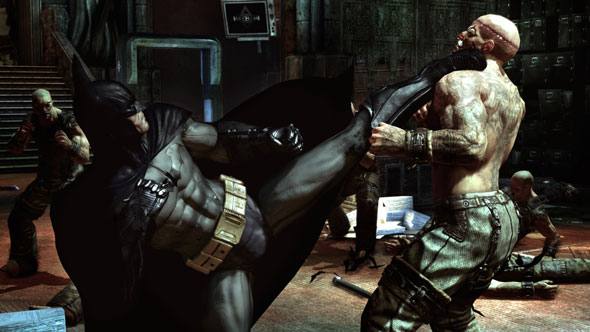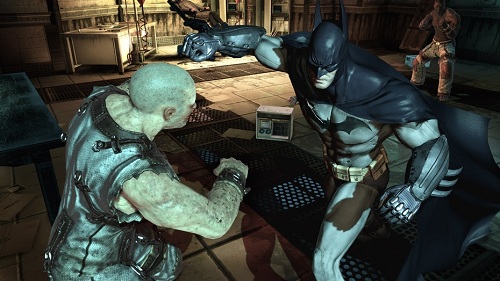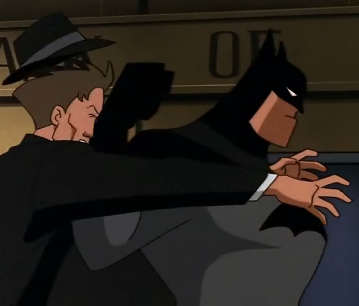Because I’ve been a bit negative lately, I’m going to kick off a series where we talk about things we love. ‘Kick off’ is probably the right term too, since I am going to focus on the Freeflow combat system in Batman: Arkham Asylum.
We all know Arkham Asylum stunned people by being not only a decent Batman game but a great one. This was mainly thanks to its ‘holy trinity’ (, Batman!) of gameplay elements suiting the character perfectly. Exploration was fun, stealth was predatory and the combat was elegant yet brutal.
So, let’s begin there. The most immediate thing about the combat is that it really makes you feel like Batman, capturing the essence of the character. Batman’s boots tread softly and silently yet are capable of delivering a solid THWUMP! to enemies. Batman is not about flashy moves (not that he’s adverse to them); he is about being economical. Get the job done and do it efficiently.
The controls are built to accommodate this feeling. Most players can get by with the basic four buttons: attack, counter, stun and dodge. There is no heavy attack button because every attack is a heavy one. Initially, only the first two are required. Batman does not have to dodge around, looking for openings. Working in any direction, attacking takes him to the enemies and countering knocks them away (if not, out). Only when more varied enemies start appearing do the other facets come into play.
And these demonstrate how the difficulty scales up beautifully. Although the game throws new threats at you, there are always simple ways to deal with them. It keeps you on your toes without overwhelming you. Gadgets are generally optional, with the batarang being the exception; it makes it much easier to dodge charging Titans but is not, in fact, a necessity. Sensibly, even that is kept to a single button press and automatically heads towards its target. Everything is designed to keep things moving. There are no stilted attack patterns or stupid QTEs spoiling the pacing of the action. There may be combos, but they are not the button-memorising kind or where an enemy might only be susceptible to one particular sequence of inputs.
Most fighters will boast about being ‘easy to learn, hard to master’ and, in my experience, they’re all talking bullshit. Arkham Asylum is the true epitome of this concept (even if it doesn’t appear as ‘hard’ as other examples). Button-mashing players will still find satisfaction in the combat since Batman doesn’t have to string together large combos to get by; ‘responding appropriately’ to enemies will usually be enough in the story. However, correctly timing attacks will yield critical strikes which are far more effective and rewarding. Higher combos unlock more brutal moves as well as allowing players to send Batman flying right across the room. It’s these more advanced elements that take combat to a new level. Once players have unlocked new moves and gadgets (I know I’ve complained about this before but we’re being positive here, go with it), they have a greater toolset with which to subdue and manipulate enemies. Because, really, the ultimate aim is to utterly confound the crowd of goons and avoid being hit at all.
The combo system is tailored so that players remain on the offensive. Chaining moves is on a one-second time limit but this encompasses all available options from gadgets to stuns through to dodging. The interesting exception is that only one solitary dodge away from enemies is permitted without breaking a combo, whereas dodging over enemies is, in theory, unlimited and, as an added bonus, effectively stuns them.
Not all this is apparent at first but that’s partly why the Challenge Mode is a great addition. Here, players can experiment with their technique, discovering how much deeper it is. Rather than memorising move lists, players are learning the natural cadence of a fight; getting a sense of attack timings, how to best manoeuvre around groups and when to mix in gadgets. This mode is also where Rocksteady are able to let loose a bit more, introducing Extreme versions of the challenges where the trickier aspects of fights (multiple Titans, electrified floors, gun cabinets) get a bigger look-in, pushing the player’s skills to the limit (or the extreme, if you will). As far as I am aware, it is unfortunate that the option for turning off Counter hints is not present in this mode; allowing players to go for an even tougher challenge and a sense of true mastery.
Everything comes back to why the game really triumphs: Rocksteady fully embraced what Batman is about and built around that. As Batman doesn’t use guns or lethal force and very rarely wields anything as a weapon, they found other ways to ensure combat remains engaging. Therefore, all the attacks feel satisfying, aided by hyperreal sound effects; Batman chooses his battles, never going face-to-face against an overwhelming amount of foes, meaning no enemy spawn points (except maybe during some bosses); and the Counter system circumvents the one-at-a-time pattern of enemy attacks that plague most action games whilst tying into the backhand punch for which Batman is so famous.
All this is helped by the impressive animations which blend together almost perfectly. The absence of set combos and the way fights evolve around this means you’re not witnessing the same old canned motions quite so frequently. At the best of times, it can look like a well-choreographed fight sequence, able to rival those seen in martial arts films (proper direction required, however). Of course, to its benefit, the combat is only part of the overall gameplay during the story, meaning it never outstays its welcome and makes for eventful and memorable encounters.
And that’s what I love about it. It is constantly thrilling, satisfying and works within the context. I’d even go so far as to say it is pioneering; a true product of smart design.
In short: Rocksteady put the ‘bat’ in ‘combat’.
For Love Of The Game is where we take the time to highlight one particular aspect we liked. We might not always appreciate everything a game has to offer but there may be something that we feel deserves attention. This can range from the music and environments, right through to characters or mechanics.



